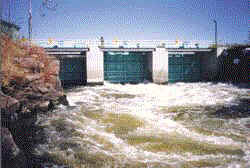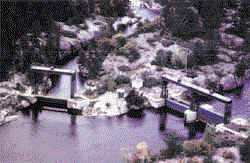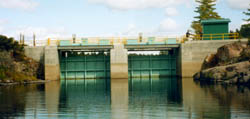The French River Dams
 Portage Dam
Portage Dam
-
Originally built in 1948, the current dam was built in 1992.
-
Summer lake level discharge capacity of 215 cubic meters per second into the French River, the largest of the dams.
 Big Chaudière Dam
Big Chaudière Dam
-
Built in 1916, a project for a replacement dam is currently under way.
-
Summer lake level discharge capacity of 185 cubic meters per second into the French River.
 Little Chaudière Dam
Little Chaudière Dam
-
Original dam completed in 1916, the current dam was built in 1996.
-
Summer lake level discharge capacity of 67 cubic meters per second.
Other French River Channels
During the summer, two nearby natural overflows; Hall Chute and Island 'B' Channel, provide a flow of 26 cubic meters per second into the Little French River, which empties into the main channel of the French River.
How Changes in Conditions Effect local Water Systems
Lake Nipissing
-
When Lake Nipissing is lowered one centimetre over one day, the French River may rise by over 48 centimetres.
-
If watershed soil conditions are very wet, Lake Nipissing may rise four times the amount of rainfall received.
-
During the boating season, the Lake Nipissing water level may fluctuate up to half a meter.
French River
-
During the initial spring melt, inflows into the French River can increase by 100 cubic metres per second within four days in the Dry Pine Bay area, resulting in a water level rise of 60 centimetres on the river.
-
An adjustment of the water levels at the French River dams affects Wolseley Bay in one day, Dry Pine Bay in three to five days, and Hartley Bay in four to eight days, depending on weather conditions.
-
During the boating season, Wolseley Bay water levels may vary 1.85 metres. Dry Pine Bay levels may vary 2.3 metres.
-
The Hartley Bay water level is affected by the French River, the Pickerel River and the Wanapitei River. Water levels may vary as much as four metres during a 12-month period.
- Date modified: